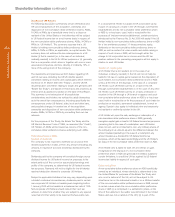RBS 2005 Annual Report Download - page 258
Download and view the complete annual report
Please find page 258 of the 2005 RBS annual report below. You can navigate through the pages in the report by either clicking on the pages listed below, or by using the keyword search tool below to find specific information within the annual report.
256
Additional information
2 United States
As the ultimate parent of Citizens’ subsidiary US banks, the
company is a bank holding company within the meaning of,
and subject to regulation and supervision under, the US
Bank Holding Company Act of 1956, as amended (the
‘BHCA’), by the Board of Governors of the Federal Reserve
System (the ‘Federal Reserve Board’). Under current
Federal Reserve Board policy, the company is expected to
act as a source of financial strength to its US bank
subsidiaries.
The BHCA generally prohibits the company from acquiring,
directly or indirectly, the ownership or control of more than
5% of the voting shares of any company engaged in non-
banking activities in the United States unless the Board has
determined, by order or regulation, that such activities are
so closely related to banking or managing or controlling
banks as to be a proper incident thereto. In addition, the
BHCA requires the company to obtain the prior approval of
the Federal Reserve Board before acquiring, directly or
indirectly, the ownership or control of more than 5% of any
class of the voting shares of any US bank or bank holding
company. With passage of the Gramm-Leach-Bliley Act
of 1999 (the “GLBA”), bank holding companies that have
met certain eligibility criteria and elected to become
‘financial holding companies’ are permitted to engage
in a significantly expanded set of non-banking activities,
including making controlling investments in non-bank
business ventures without prior approval from the Federal
Reserve Board under the Federal Reserve Board’s
merchant banking authority. The company elected to
become a financial holding company effective in
February 2004. In November 2005, the company notified
the Federal Reserve Board that it had commenced its
merchant banking activities through its US subsidiary,
Greenwich Capital Markets, Inc.
The company’s US bank and non-bank subsidiaries, and
the Royal Bank’s US offices, are subject to direct
supervision and regulation by various other federal and
state authorities. Citizens’ state chartered bank
subsidiaries are subject to regulation and supervision by
state banking authorities and the US Federal Deposit
Insurance Corporation, and the Royal Bank’s New York
branch is supervised by the New York State Banking
Department. The company's US insurance agencies are
regulated by state insurance authorities. The company’s US
securities affiliates, including Greenwich Capital Markets
Inc., are subject to regulation and supervision by the US
Securities and Exchange Commission and various
self-regulating organisations. The futures activities of
Greenwich Capital Markets, Inc. are also subject to
oversight by the US Commodity Futures Trading
Commission and the Chicago Board of Trade. Charter One
Bank N.A., Citizens Bank NA, and RBS National Bank are
regulated and supervised primarily by the US Office of the
Comptroller of the Currency.
3 Regulatory developments for capital and risk management
The Basel Committee on Banking Supervision, which
meets at the Bank of International Settlements in
Switzerland, sets the standards for firm’s weighted risk
asset calculations and associated regulatory capital
triggers. This Committee published a revised framework,
called Basel 2, in June 2004.
In the EU, the framework became law through the Capital
Requirements Directive (EU CRD) and associated changes
to national laws or regulatory guidelines (for example the
FSA’s Integrated Prudential Sourcebook). Within the US,
regulators have the flexibility to implement Basel 2 directly,
after a Final Notice of Prudential Rulemaking expected
later in 2006. Full adoption of these new rules comes into
force across the EU on 1 January 2008 and the US on
1 January 2009.
Application of Basel 2 differs between jurisdictions. The EU
is applying Basel 2 to all banks and investment firms.
The US is taking a different approach, mandating that their
largest internationally active banks use the ‘Advanced’
approaches for credit and operational risk calculations;
other banks can either remain on Basel 1 (or a modified
version thereof, called Basel 1a) or ‘opt-into’ Basel 2. Our
US subsidiary, Citizens, currently falls outside the group of
mandated Basel 2 banks for the purposes of US regulation.
Basel 2, based around three Pillars, presents a
fundamental change to the current capital adequacy
regime and will have wide ranging consequences for the
banking industry as a whole. RBS is making good
progress in satisfying the requirements for credit, market
and operational risk which, together, represent the
minimum capital standards (Pillar 1). Work on the other
Pillars of Basel 2, supervisory review (Pillar 2) and market
disclosures (Pillar 3) are also progressing as the standards
are emerging from the regulatory authorities.
Additional information continued
























